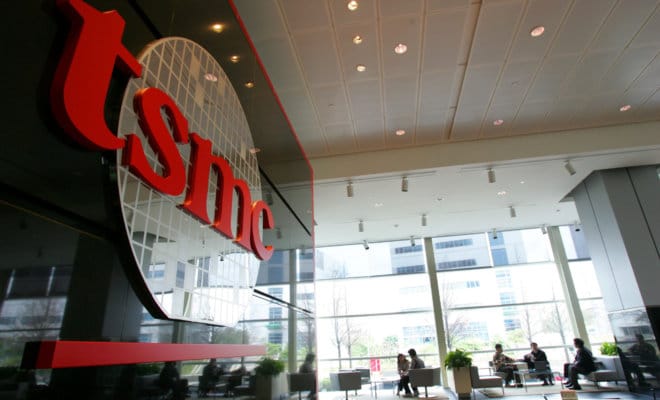Business
What’s Good For Apple Isn’t Always Best For iPhone Suppliers

The lobby of Taiwan Semiconductor Manufacturing Co. (TSMC) headquarters in Hsinchu, Taiwan, in 2010.Photo: Maurice Tsai/Bloomberg
Shares in suppliers to the world's most valuable company jumped at the outset from Asia to Europe, but many subsequently gave up their gains or slid into the red.
Apple turned in a strong quarter with revenue, profit and forecasts all coming in ahead of analysts’ estimates. But that isn’t necessarily good for the hundreds of iPhone suppliers around the world, contrary to the market’s initial bounce.
Apple’s better-than-expected results stemmed in part from the sale of ancillary goodies from games to cloud storage. None of those benefit hardware partners such as Taiwan Semiconductor Manufacturing and Hon Hai Precision Industry, whose fortunes are more closely tied to iPhone unit sales — which rose just 2.9 percent in the March quarter despite a 10th-anniversary device that was supposed to drive a super-cycle of demand.
Even a slight slowdown in iPhone sales can mean a huge hit to those suppliers. It’s the price of participating in Apple’s production chain: companies build expensive factories in advance of gadget cycles so even modest misses hammer profits.
Take Taiwan’s Pegatron, which assembles the iPhone 8 and ramped up capacity in anticipation of a surge in business last year. A subsequent shortfall in demand led to lower utilization rates across its factories and operating margins almost halved to 1.61 percent last year. Both Pegatron and Hon Hai — Apple’s principal assemblers — reported net income falls in 2017 even as their biggest customer racked up record profits.
“Apple is benefiting from increased average selling price. Yet volume, which is key to suppliers’ financials, is only growing a little,” said Arthur Liao, an analyst at Taipei-based Fubon Securities.
Shares in suppliers to the world’s most valuable company jumped at the outset from Asia to Europe, but many subsequently gave up their gains or slid into the red. A number have yet to recover from the fear-driven selloff of past weeks: Europe’s AMS AG surged 8 percent Wednesday but remains down by about the same magnitude from when it warned of negative margins last week.
In Hong Kong, AAC Technologies Holdings leaped as much as 6.7 percent before ending the day down 0.6 percent. Japanese components makers such as Japan Display and Sharp finished mostly unchanged. TSMC, the main chipmaker to Apple, slid 1.8 percent while Hon Hai dived 1.3 percent.
Globally, concern about the business was fanned by suppliers such as TSMC that warned of weak demand for high-end devices or delivered disappointing outlooks: all signs that the smartphone boom that made Apple the most-valuable company is ebbing. That prompted a flurry of estimate cuts from analysts around the world.
Apple Chief Executive Officer Tim Cook hinted at additional sources of growth in terms of both geographical areas and product categories. He said India is an attractive new market for iPhones, similar to China several years ago. Cook may be addressing skepticism about its prospects in emerging markets, with China dominated by competitors from Huawei to Xiaomi and its iPhones beyond the reach of many in India.
Even if Apple does make headway in India or China — still its largest international market — there’s no guarantee its hardware partners can share in the spoils, given the U.S. company’s reputation for squeezing suppliers to preserve its own margins. It’s even in recent years begun cutting off suppliers such as Imagination Technologies Group Plc in favor of making its own components, such as chips.
In the longer term, the chip and component makers that remain in its orbit could still benefit as smartphones incorporate bells and whistles from augmented reality to artificial intelligence — all of which need more processing muscle and silicon.
“From the component or the chipmaker’s perspective, the market is still ripe because if you look at the smartphones now, the computing demand is increasing a lot more,” said Kiranjeet Kaur, IDC’s Asia Pacific senior research manager.
(c) 2018, Bloomberg
